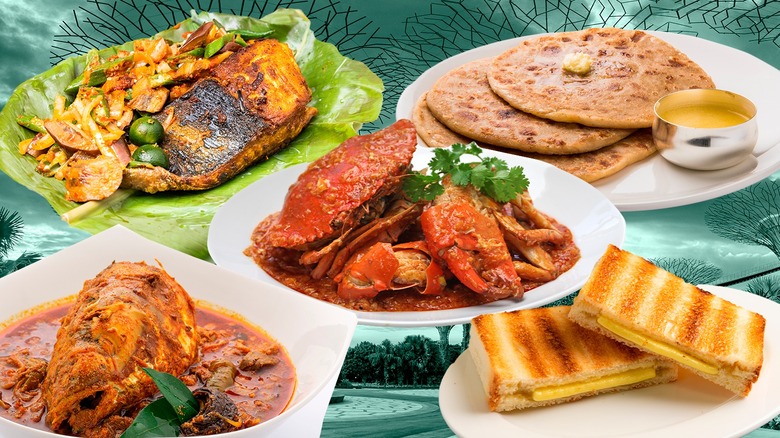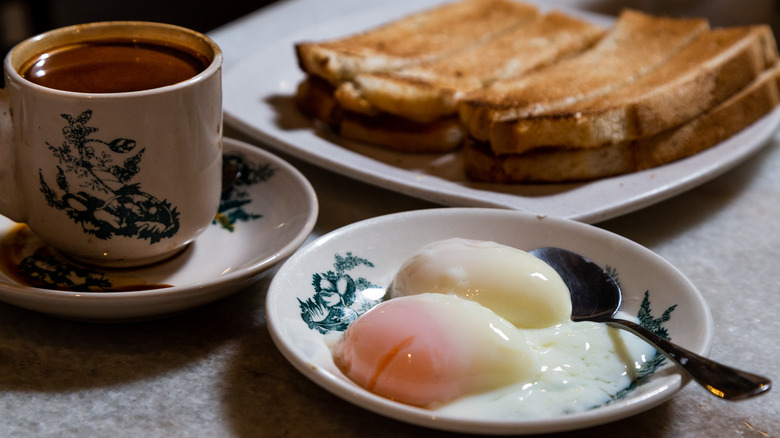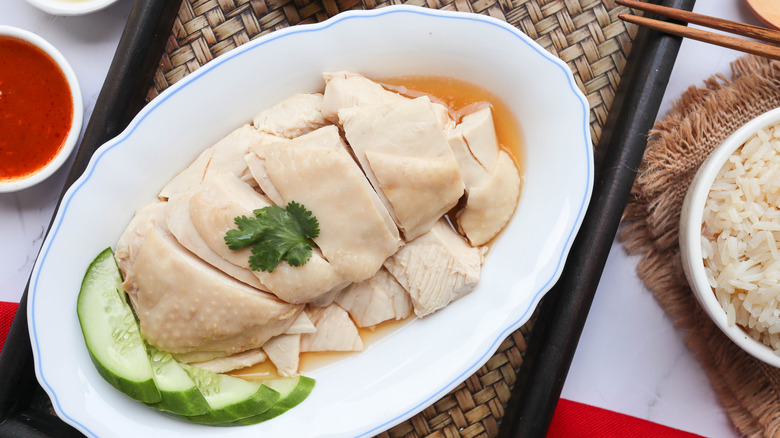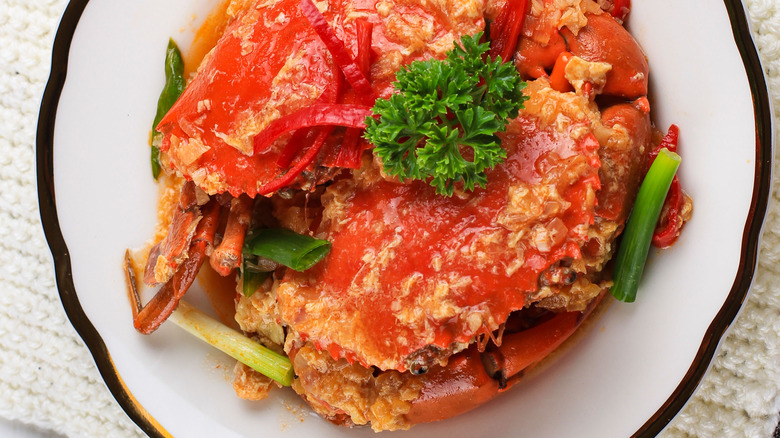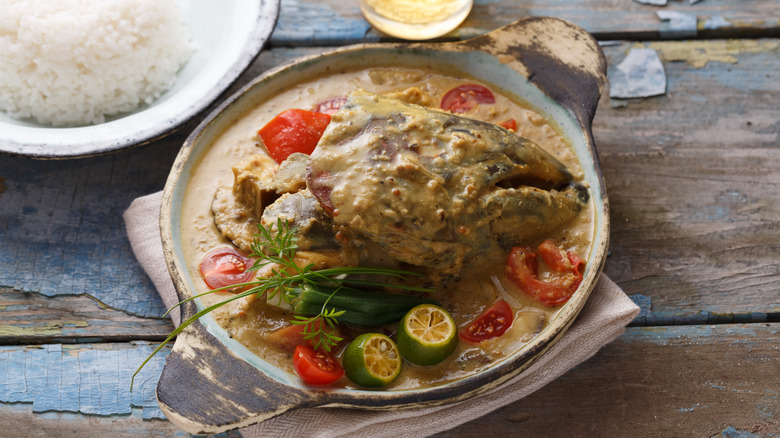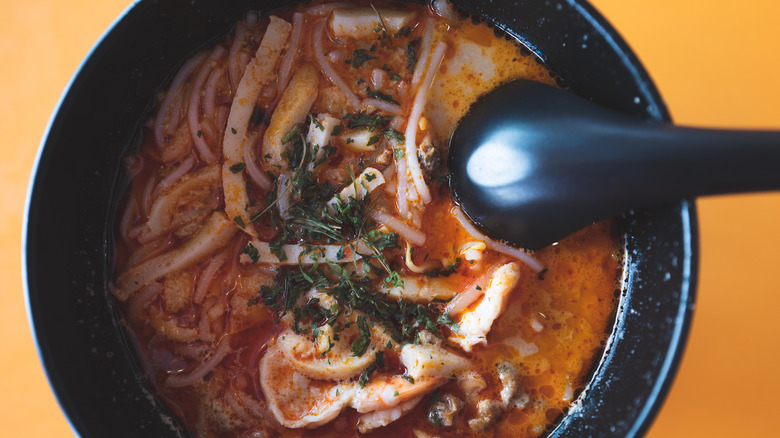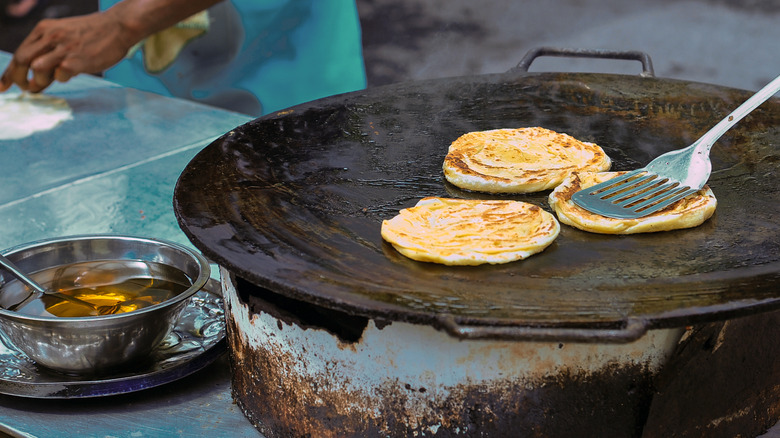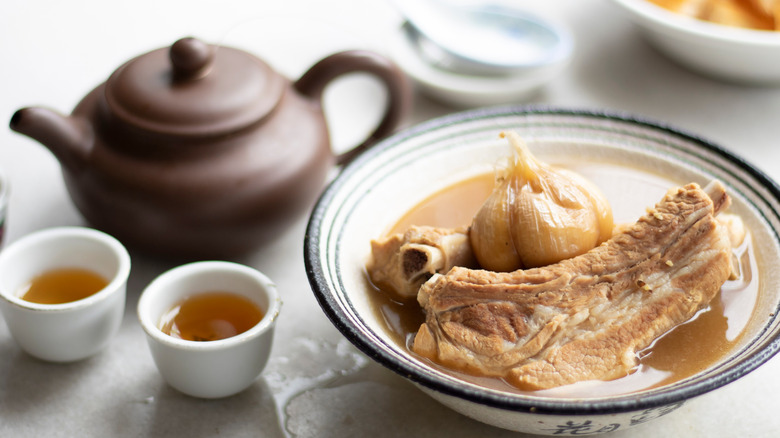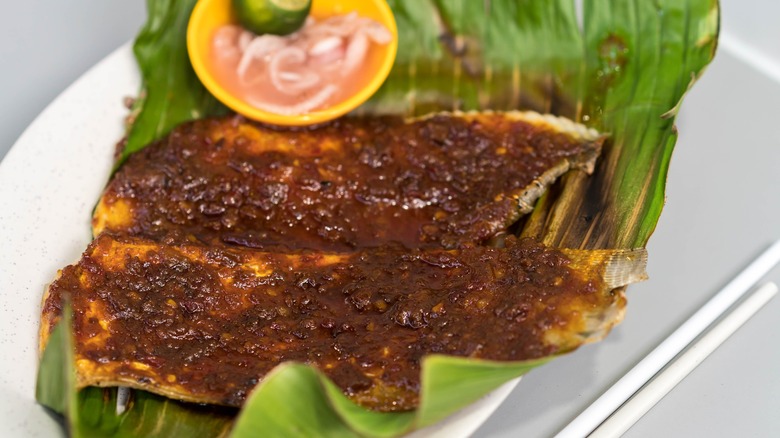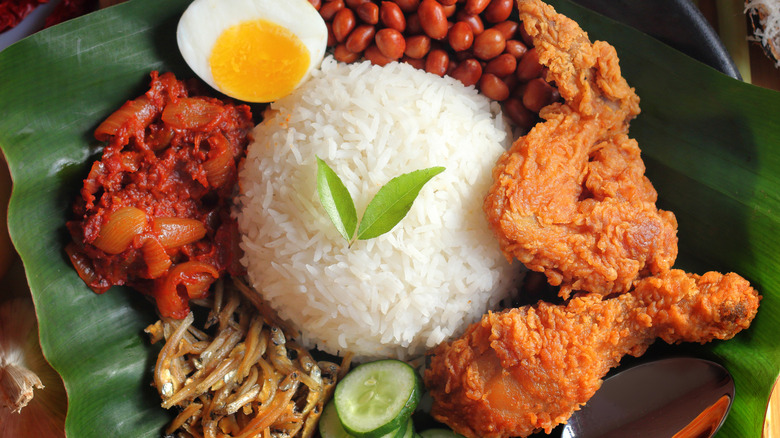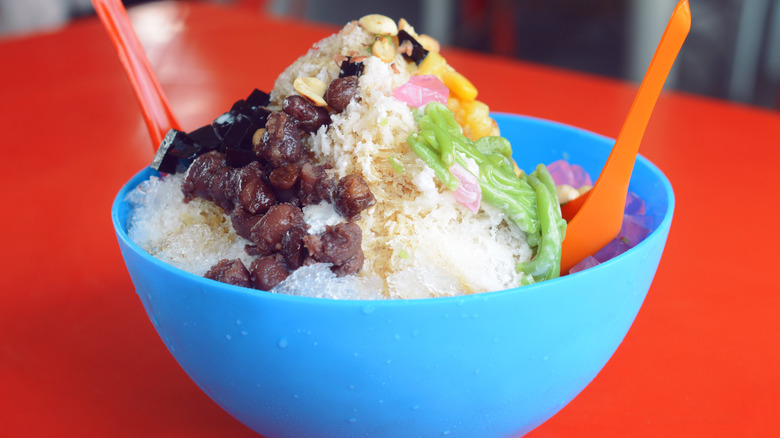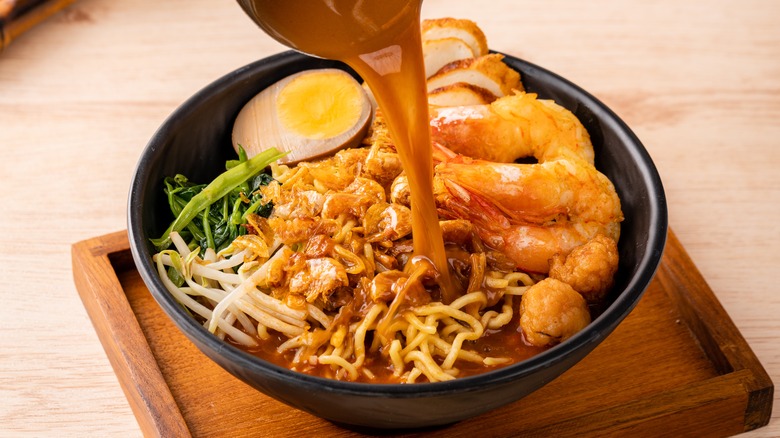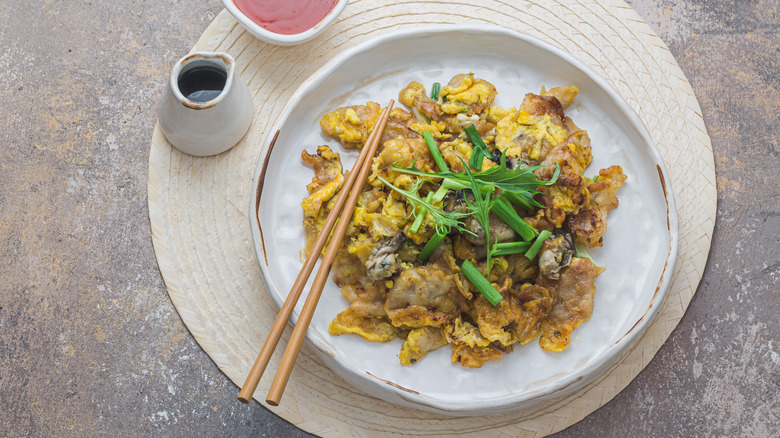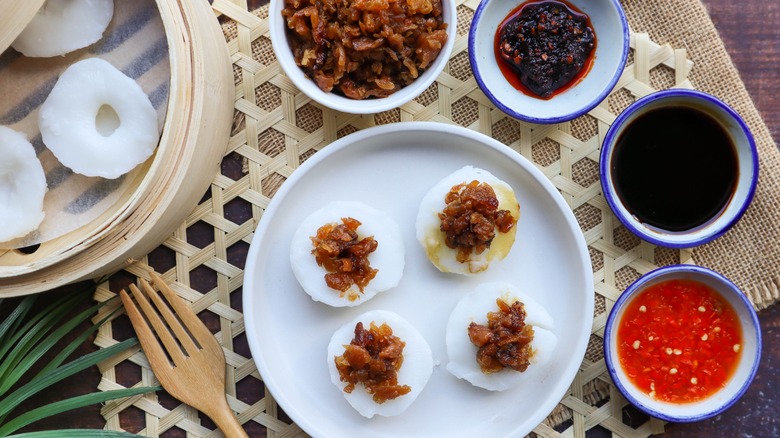15 Foods And Drinks To Try In Singapore
For such a small country, there is a massive appetite in Singapore. The island nation is awash with culinary delights in every corner you look, from the towering ambiance of bustling hawker centers to the simple, singular street stalls wafting smells so bold you think you could take a bite out of the air. Of all the world's great gastronomic destinations, The Lion City is near-unparalleled in its offerings and remarkable in its welcome approach to hungry travelers.
Among the things that make Singaporean cuisine so unique is the diversity of influences that have shaped the foods here. Meat, seafood, and noodles are popular and come in styles heavily determined by immigrant populations from China, Malaysia, Brunei, India, and farther. On a recent trip to Singapore, we relished as much time as possible learning about some of the dishes that are most craved in the city's food scene. The results? 14 foods you shouldn't fail to try when visiting Singapore.
Kaya toast
Kaya toast is a perfect breakfast food by nearly any standard, thanks to a texture and flavor that can satisfy a range of preferences. The dish is served as two pieces of toast spread with cold butter and kaya (a coconut jam) and intended to be stacked as a sandwich. Kaya toast often comes alongside a bowl of half-boiled, runny eggs. Mixed with dark soy sauce, the side serving is a pool for salty, rich dipping that can balance the slightly sweet and tropical nuances of the coconut-decked bread.
What hungry breakfast diners get as a result of the combo is a stack of grilled toast, the middle section softened by toppings with crisp corner edges that are soon to wilt once dunked into the silky egg mixture. Joining the plate with a cup of fresh coffee invokes the true essence of simple pleasure and reminds us that sometimes the most satisfying food comes from the most humble ingredients. We knew breakfast was important, but maybe not this transcendental.
Hainanese chicken rice
Hainanese chicken rice may be one, if not the most famous Singaporean food and many regard it as the island country's national dish. In fact, Hainanese chicken rice often gets confused as a transplant dish that arrived in Singapore from the southern Chinese island of Hainan. This is true only in part: On a recent visit to The Garden City, we were taught that Hiananese chicken rice (as it is made in Singapore) is a genuine original, despite being adapted from another Hainan Island dish called Wenchang Chicken.
Just one mouthful of this delectably succulent meal makes it easy to see why Hainanese chicken rice has become so well known — and why so many want to claim it. The components are simple: slow-poached chicken is served alongside fluffy rice, which is pre-fried in chicken fat before being cooked in the same broth in which the meat was boiled. Often, the taste of the rice may be further brightened by the inclusion of A-list spice cabinet celebrities (think: ginger, garlic, and others).
While good enough to eat all on its own, a full plate of Hainanese chicken rice may come with an entourage: Dipping sauces, a side of fresh cucumbers, soy-soaked eggs, or bean sprouts are all common side dishes. Further, there are different spins on the classic chicken plate, such as the dark and savory soya chicken rice, which is the signature dish at the world's first (formerly) Michelin-starred hawker stall.
Chili Crab
If you want to eat some Singaporean food with a less contested origin, order up a plate of chili crab. Although this meal can now be found widely throughout Lion City and neighboring Malaysia, it is believed to have first been developed in Singapore during the 1950s by a cook named Cher Yam Tian. Originally, Tian served stir-fried crabs drenched in tomato sauce gravy. By substituting chili sauce, she created a new variation that skyrocketed in popularity. Other creative deviations followed, such as a sour gravy that uses acidic ingredients like lemon juice, vinegar, and sambal.
Singapore is well known for its hawker centers and street food stalls, but chili crab isn't a dish you'll likely find in these places — mainly because of the higher cost (it'll take quite a few crabs to fill you up) and the involved eating process. The crab part of the dish is mud crabs, a common regional seafood. The shells of the crab are lightly smashed or chopped before being double deep fried, once in oil and then again in the spicy (or sour) gravy mix, which may be thickened with flour or eggs before it's presented to hungry diners.
Despite coming served with the hard body still on, you don't eat this like a soft-shell crab. Instead, use anything you can get your hands on to pick through the insides and find the saucy bits of meat. Fingers work especially well.
Fish head curry
As one of the world's major port cities and a former colonial holding of the British Empire, Singapore has long been a nexus of international and local influences. Few dishes tell that story as starkly as fish head curry. Combining spices that are commonly found in South Indian cooking with an ingredient that's very particular to certain Chinese cuisines, this dish offers some of the richest and most complex flavors you're likely to find while eating in Singapore ... if you don't mind making eye contact with your meal, that is.
There are as many different takes on the curry part of this bowl as there are fish heads to cook and hands to stir the pot. When eating fish head curry, you may find spicy variations, some that are a bit sweeter, or still others that have a sour tang of tamarind. It's common to taste a base made from coconut milk, which creates a long, silken finish when sipped with tender fish meat.
Depending on who is cooking, vegetables like okra, tomato, and eggplant can be found floating in the bowl, modeling a small-scale recreation of Singapore's extensive island system. That said, you're unlikely to find a lot of riffing with the type of fish heads used. Quality red snapper is essential to making fish head curry.
Katong laksa
Laksa by itself is not something that can purely be defined as a Singaporean food. A spicy noodle soup, laksa comes in many forms across Southeast Asia. There are numerous styles, such as asam laksa, which is sour and fish-based; curry laksa, which is based on coconut milk and may be sweeter (and nearly always richer); and Sarawak laksa, which uses a special, secretive paste made from sambal and shrimp paste. It only makes sense then that Singapore would also have its own unique sort of laksa. Katong laksa originates from the Peranakan-populated Katong city district and, as such, is a truly local twist on a common dish.
Katong laksa starts with a broth that calls to mind the Singaporean horizon on a clear evening. The fiery, red-orange-yellow soup is colored and flavored with a spicy paste made from potent ingredients like turmeric, ginger, garlic, galangal, red chilies, shallots, and belachan (shrimp paste) — among other ingredients. It's balanced with velvety coconut milk and herbaceous Vietnamese coriander, then filled out with rice noodles and bean sprouts. Fish cakes, prawns, and puffed tofu provide added protein heft. Altogether, Katong laksa imparts a lip-tingling taste that's hard not to slurp down all at once.
Roti prata
Like laksa, roti prata is one of the more well-traveled foods on this list. You'll find it in Malaysia, Brunei, and Thailand, too, with the regional special considered extended family to the Indian roti style. Still, it's definitely something you'll want to keep an eye out for when strolling the streets of the Garden City, and something you're not likely to miss.
Half the fun of eating roti prata in Singapore is watching the way it gets prepared. Deftly-handed street vendors pull, stretch, and slap the dough around a searing-hot flat top while simultaneously engaging with those passing on the street. If you didn't know what you were walking in on, you might guess the roti makers are spinning pizza pie, but as the dough gets dangerously thin, you'll quickly realize that this is something else entirely.
As the roti bubbles on the grill, you'll have the chance to add sweet or savory mix-ins. Personal favorites include egg with condensed milk, a combination that invokes the sweety-salty pleasure of pan-fried French toast (minus the spices). Nutella, chocolate, or fruit spreads are often readily available too. Before ordering, be sure to look at the customer in front of you to gauge whether your particular street vendor is whipping up the right roti prata texture for your preferences. Depending on who you order from, a roti can come out dense and cloudlike or crisp-crackly.
Bak kut teh
Translated from the Hokkien dialect, bak kut teh means "meat bone tea," but it's not exactly what you might think. The "meat bone" and "tea" components of this meal are actually two different parts, the latter being a beverage doled alongside the former, a hot soup made of drippingly delicate pork ribs soaked in a broth of various spices, aromatics, and flavorings. While a steaming bowl of pork ribs will seem more aligned with lunch or dinner times in the Western world, bak kut teh is served as a breakfast soup in Singapore, which should explain why it comes accompanied by tea.
When looking to fortify yourself with an early morning bowl of bak kut teh, be aware that there are different methods of making the soup. Teochew style, perhaps most common in Singapore, has a clearer broth laced with a heavily piquant garlic and pepper profile. Other ways of creating bak kut teh, like the Hokkien fashion, use more of an herbal base, while the Cantonese version features the saline addition of soy sauce. No matter what version you choose, the soup is rich in flavor and studded with nourishing pieces of meat floating within.
Char kway teow
Some hawkers stick to serving one well-practiced staple, while others, at most, offer only a handful of unique specialties. Even with that considered, depending on which direction you've headed, the food market you find yourself in may have more than 100 stalls. Even if every stall was serving a single dish, that's still a big menu. With that in mind, it's good to stay knowledgeable of a few approachable comfort foods that can give you some ordering confidence before exploring deeper.
Char kway teow is one such dish. It is thought of as a humble food thanks to its affordability, street-tried and wok-fried preparation, and rib-sticking ingredients: Flat rice noodles, yellow wheat noodles, bean sprouts, fish cake, egg, Chinese sausage, and a mix of dark and light soy sauce are all it takes to stir-fry this meal into existence. For the most authentic flavor, look for a hawker using charcoal to heat the stove and ladling lard into the frying process. Bonus points if your char kway teow comes with a lime wedge, a dash of chili sauce, and a banana leaf wrapper.
Barbecued stingray
As you might expect for an island country, seafood is integral to Singapore's national cuisine. But, if fish head curry doesn't suit your dining preferences, another hawker classic to look for is barbecued stingray. The dish is widely served across Singapore and Malaysia, where it is regarded for its strong flavor profile that contrasts with the soft tenderness of the fish.
It's important to note that this creature's tail is the only poisonous part. Other areas of the fish, such as the wings, are commonly cooked in various Southeast Asian cuisines. The meat harvested from a stingray has a medium chewiness comparable to scallops, with the sea breeze sweetness that crab and lobster are regarded for. Yet, you're unlikely to get a singular taste of it when ordering this dish from vendors.
At hawker centers, the thin filets of stingray are topped with a heat-bearing sambal paste, grilled, then sometimes served in a banana leaf with lime, onion, or more peppers on the side. Mostly used to add spice, a sambal marinade can also include sweeter notes (sugar), acidity (vinegar), or burst with umami (shrimp paste), depending on the specialized recipe. We recommend trying many offerings of barbecued stingray, and often.
Nasi lemak
Nasi lemak translates from Malay to mean "rich rice." This translation reveals a lot; order nasi lemak at a hawker stall or restaurant, and you'll get much more than just a bowl of grains. Fried fish, poultry, or egg are regular accompaniments for adding more substance to the plate; sambal paste increases the intensity; cucumbers may be sliced and provide for their cooling effects, or peanuts for some grounding earthiness. But, true to the name and despite all the added personalities, the rice is the anchor point of this meal.
What makes this grain so rich is the brew used for cooking it. Soaked in coconut milk and pandan leaf, the rice becomes hearty and full of tropical flavors. Where the creamy, equatorial accents of coconut might otherwise get overwhelming, the green pandan cuts a vegetal track of freshness that balances. During a recent trip to Singapore, we were lucky to sample some nasi lemak that was tinged a faded blue from the inclusion of butterfly peas. The result was a floral, botanic punch that will forever crave as a side to fried chicken.
Ais kachang
Situated close to the equator, Singapore has relatively consistent weather patterns. A sea wind can pick up to cool things off, but overall, there are a lot of hot days to deal with as well. With that in mind, many cuisine options have been developed to help cool folks off. Ais kachang is a treat that can multitask in those moments when the heat starts to scramble your thoughts like eggs on a sidewalk. It keeps your temperature down, helps you hydrate (a bit), and satisfies your sweet tooth.
Ais kachang starts with machine-shredded ice — a life-restoring product in Singaporean temperatures. From there, the fluffy, shaved ice becomes whatever you want. Textural landmines of red beans and corn are mandatory (from our point of view, at least). You might drench your kachang with an array of sweet snowcone-style syrups or add agar agar jelly. From there, make it rain down a mixture of durian or mango, peanuts, condensed milk, or herbal seeds.
Scoop it up before it melts, or drink it like a slushy when it inevitably does. To find ais kachang, keep your eyes peeled for signs reading ABC (ais batu campur, or "mixed shaved ice").
Hokkien prawn mee
After trying a cooling snack like ais kachang, downing something hot and steamy might not seem very appealing. In Singapore, however, the belly rumblings are never far off. You have to eat again at some point, and when the time comes, we suggest searching out hokkien mee. In its simplest form, hokkien prawn mee is a stir-fried wonder. Two types of noodles are used — vermicelli and yellow noodles — which are then piled high with weighty ingredients like prawn and pork belly, egg, squid, and even crispy fried pork fat.
The concoction is merged with all its glorious parts before soaking in a decadent stock made from steeped pork bones and prawn heads. With enough heat and cooking time, most of that liquid dissipates into the noodles, so don't expect anything akin to a soup. Nor will it be crispy either; the broth doesn't allow for flakey, hardened noodles. Instead, hokkien prawn mei is a little bit moist and a lot of everything you want from Singaporean food. When the smells of the city entice your appetite to another round, this is a great dish to go with.
Orh jian
Despite what the French might have you believe, the world is full of different omelet styles. In every culture where eggs are a part of the cuisine, someone is taking the pan-fried approach to get the most from their beaten ingredient. Singaporean food is no different, although one particular omelet of the region has an especially soft spot in our stomach. Orh jian, an oyster omelet, is another common hawker food. Made of a starch and egg batter folded with fish sauce and aromatics around dense and chewy oysters, the beauty of orh jian lies in the texture.
Find a skilled hand to cook your omelet, and what floats towards your mouth are crackling, flakey edges that slope gently inward to soft, gooey centers, and steaming mouthfuls of seafood. We'll level with you here: The often-greasy mix handed down from on high isn't the most Instagram-worthy food. Maybe that's a relief because you'll finally get to eat before your phone for once. The chaotic mashup has an umami-bursting satisfaction that's unlike many other dishes you're likely to stumble upon. We know we said this one was a textural journey, but the flavor is really something, too.
Chwee kueh
Light yet sustaining. Airy yet flavorful. Chwee kueh is a case study on how the pairing of contradictions can sometimes lead to blissful experiences. The dish was brought to Singapore by Teochew people, Chinese immigrants from the Chaoshan region. Whether you try chwee kueh as a breakfast food or with a hot cup of afternoon something, the playful texture meets the needs of any time. Chwee kueh is made with a blend of rice flour and water, which are put together and then steamed in an aluminum cup to form a signature round shape.
As with nearly every street food in Singapore, the final texture of chwee kueh depends on who prepared the batter and how. Some recipes may lead to more firm cakes (which, all in all, are still pretty soft), while others deliver springy, spongey pads. Chwee kueh comes with a preserved and salted radish topping and some chili sauce on the side. A good rendition will also carry the grain-sweet undercurrent of cooked starch.
